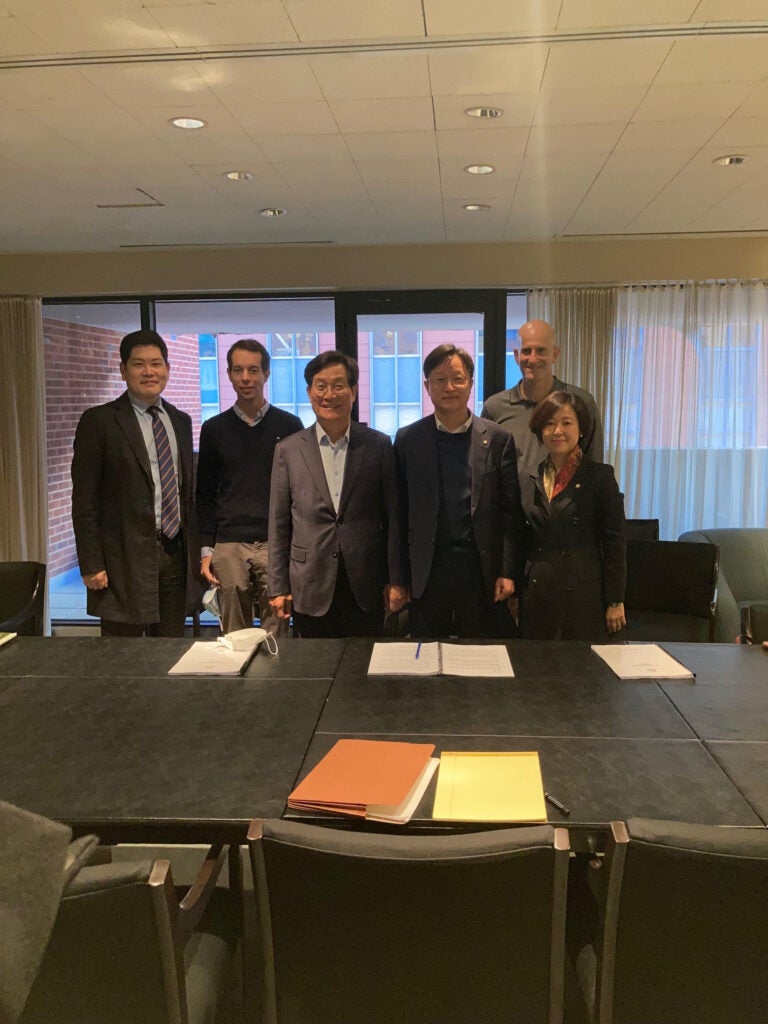2021 News
December 2, 2021
Honoring the Life and Career of Professor Martin Evans

With an extraordinary sense of sorrow, the Economics Department informs the Georgetown University community of the sudden and tragic passing of our colleague Professor Martin Evans on Friday, November 19, 2021
A part of the Georgetown community for the past twenty-five years, Professor Evans received a Bachelor of Science (Honours) in Economics in 1983 from Bristol University in the UK. He came to the U.S. to work on his doctorate at Princeton University. He completed his Ph.D. there in 1987 and subsequently took an Assistant Professor position at the Stern School of Business at New York University. He was promoted to Associate Professor at Stern before moving to Georgetown University in 1996. He became a Full Professor in the Economics Department at Georgetown University in 1998. In addition to his position in the Economics Department, Professor Evans held the position of Professor of Finance in the McDonough School of Business from 2006 to 2012.
During this time, he held visiting positions at the University of Michigan, The Wharton School, London School of Economics, and Princeton University. He was an advisor to the Research Department at the International Monetary Fund and holder of prestigious fellowships at the Bank of England, Princeton University, New York University, and Georgetown University.
Professor Evans was a distinguished scholar. He made substantial and influential contributions in international finance, particularly in the study of market microstructure of exchange rates. He published over 50 journal articles, book chapters, and working papers, some of which were supported by prestigious grants from the National Science Foundation. His two textbooks, Exchange Rate Dynamics, Princeton University Press, 2011 and Studies in Foreign Exchange Economics, World Scientific Press, 2017 are widely used in Ph.D. programs, and by researchers across the world.
His standing in the academic community was reflected by editorial positions at the Economic Journal, the Journal of International Money and Finance, the Journal of Money Credit and Banking, and the Journal of International Economics. At the time of his passing, he was a Research Economist at the National Bureau of Economic Research.
Given his range of research interests, Professor Evans taught a variety of courses in both Georgetown College and McDonough and this included courses at both the undergraduate and graduate levels. He was a mentor to junior faculty and, as a sought-after Ph.D. advisor, his supervision resulted in some highly successful graduate placements.
Professor Evans was a lively colleague and regular member of the departmental “lunch group.” Those of us in the group will miss his banter, musings, and humor.
At home, Professor Evans is survived by his wife, Liz Evans; daughter, Sophie Evans; son, Jeremy Evans; and Bernese Mountain dog, Leo. He took great pride in watching Sophie and Jeremy graduate from Princeton, frequently attending their respective choral concerts and rugby games. He could make or fix just about anything, but above all, he will be remembered in his English garden, which he built for his family.
November 11, 2021
The GEC Network Virtual Event

Chile’s Post-Pandemic Challenges: A Conversation with Rodrigo Cerda
Featuring:
Rodrigo Cerda
Finance Minister of Chile
Moderated by:
Dr. Alejandro Werner
Founding Director, Georgetown Americas Institute
Dr. Micael Castanheira
Research Director, Fonds National de la Recherche Scientifique
Tuesday, November 16, 2021
10:00 a.m. – 11:15 a.m EST
4:00 p.m. – 5:15 p.m. Brussels Time
Location:
Online Zoom Webinar
This conversation with Minister Rodrigo Cerda, finance minister of Chile under the administration of President Sebastián Piñera, will address a number of important issues related to Chilean public policy, particularly focusing on the country’s recovery from the COVID-19 pandemic. Dr. Alejandro Werner, founding director of the Georgetown Americas Institute, will moderate a discussion on Chilean domestic policy and Chile’s role in Latin America. Dr. Micael Castanheira, a professor at the Solvay Brussels School of Economics and Management, will moderate a discussion on Chile’s global economic integration, including implications for the long-term trade and economic relationship between the European Union and Chile.
This event is sponsored by Georgetown University Global Economic Challenges (GEC) Network, Georgetown Americas Institute, Georgetown Center for Economic Policy Research (CEPR), and Solvay Brussels School of Economics and Management (Université Libre de Bruxelles). Guests are invited to join the Zoom Webinar or watch the YouTube livestream; the event will have live captioning.
For more information, please visit the event page.
November 9, 2021
GU Economics Professors Met with South Korean Parliament Delegation

Professors Arik Levinson and Marius Schwartz from the Economics Department and Professor Raphael Calel from McCourt School of Public Policy met on November 3, 2021, with a delegation of South Korean parliament members and Hyundong Yoo, an SFS alumnus now working for the parliament, to discuss U.S. policy towards climate change.
September 30, 2021
The GEC Network Virtual Event

“The Looming Federal Debt Limit”
Featuring
Shai Akabas
Director of Economic Policy,
Bipartisan Policy Center
Moderated by
Brian Madigan
Professor of the Practice,
Director of the Master’s Degree Programs in Economics,
Georgetown University
Friday, October 1, 2021
10:00 a.m. – 11:00 a.m. EDT
3:00 p.m. – 4:00 p.m. London Time
4:00 p.m. – 5:00 p.m. Brussels Time
Location: Online Zoom Webinar
RSVP
U.S. Treasury Secretary Janet Yellen has notified Congress that the Treasury will soon exhaust its cash on hand and extraordinary measures to operate under the debt ceiling. This means that if action is not taken on the debt limit, the Treasury will be unable to meet its financial obligations by mid-October, according to the Bipartisan Policy Center (BPC).
In this online webinar Shai Akabas, the director of economic policy for the BPC, will discuss why federal policymakers need to act in the coming weeks if they intend to ensure that all obligations of the U.S. government are paid in full and on time. Brian Madigan will moderate the conversation.
For more information, please visit the event page.
This event is sponsored by the Georgetown University Global Economic Challenges (GEC) Network, Georgetown Center for Economic Research, and Solvay Brussels School of Economics and Management (Université Libre de Bruxelles).
June 1, 2021
2021 Razin Lecture Recording Available
Professor Sir Christopher Pissarides delivered the 2021 Razin Lecture and Prize keynote lecture on Wednesday, April 21st, 2021. The recording of the event and past Razin Lectures can be accessed by visiting our Georgetown University Economics YouTube Channel.
May 17th, 2021
Spring/Summer 2021 Featured Research Profile
GU economists hold serve: New research by a team of GCER Fellows and grad students show how Federer, Djokovic, and Nadal can up their game.

Are the world’s best tennis pros playing winning strategies? In their recent paper, “Disequilibrium Play in Tennis” a team of Georgetown faculty and grad students, Axel Anderson, Jeremy Rosen, John Rust, and Kin-Ping Wong, conclude otherwise. They analyze the serve directions of top pros such as Roger Federer, Rafael Nadal, and Nolan Djokovic and conclude that by changing the directions they serve to, these pros can significantly increase their probability of winning the game. For example, they predict that by merely changing serve directions at different stages of the game, Roger Federer could increase his probability of winning the service game when serving to Rafael Nadal from 82% under Federer’s current serve strategy to 89% under the authors’ calculated “best response” serve strategy. For Djokovic serving to Nadal, the authors predict that Djokovic could increase his service game win chance from 84% to 93%.
Tennis serves are made to three key directions: “wide”, “to the body” or “down the T” and these serve directions are recorded for thousands of tennis matches in an online database called the Match Charting Project. The authors analyzed the probability that a given server wins a tennis game conditional on serving to different directions using this database. A key prediction of game theory, von Neumann’s celebrated Minimax Theorem, predicts that if a server randomizes across different serve directions, then the probability of winning conditional on serving to each of the three directions must be the same. The authors’ show that this fails to hold in tennis matches between top pro players, and then use dynamic programming to calculate the chances of winning with an optimal serve strategy given the observed win chances in the data. Even though the increase in the overall probability of winning the tennis game from serving to the direction with the highest win probability is small at any particular stage of the game, a best response strategy that consistently exploits these “one shot deviations” over all possible states in the game of tennis, results in cumulative increase in the probability of winning the overall game at the start of a tennis game that is much more significant, as the numerical predictions shown above indicate.
The size of the estimated increase in win chances contradicts a main prediction of traditional “rational” economic theory, namely that high ability, highly motivated economic agents should behave in accordance with game theory and its prediction that their strategies should constitute a Nash equilibrium. That is, there is no “deviation strategy” that should result in a higher payoff for any of the players in a game. The authors’ analysis suggests one possible explanation for their finding: namely, that professional tennis players have a distorted “mental model” of their own strengths and weaknesses and those of their opponent. The rapidly growing industry of “sports analytics” may help professional tennis players to adopt a more accurate statistical understanding of their own play and those of their opponents, and might ultimately lead to play that is more consistent with the predictions of von Neumanm’s Minimax Theorem, which is a special case (applied to two-person constant sum games) of the more general concept of Nash equilibrium in multiplayer, potentially non-constant sum games.
April 25th, 2021
Registration is Now Open
for the 2021 Economics Department Razin Prize and Economic Policy Lecture. Professor Sir Christopher Pissarides will deliver the keynote on Wednesday, April 21st, 2021 at 11:00 a.m. In order to attend the webinar, you must register to receive an individualized Zoom meeting invitation. Click here to register.
2021 RAZIN PRIZE and ECONOMIC POLICY LECTURE

Professor Sir Christopher Pissarides
London School of Economics
“Technology and Jobs in the Post-Covid Economy.”
Prize Winners:
Maria Hernandez de Benito for her dissertation essay entitled “The Effect of Violent Crime on Intra-household Resource Allocation and Bargaining Power“
Dissertation Advisor: Professor Garance Genicot
Umberto Muratori for his dissertation essay entitled “Knowledge Diffusion, Markups, and Cohorts of Firms“
Dissertation Advisor: Professor Toshi Mukoyama
Date: April 21, 2021 at 11:00 a.m.
Professor Sir Christopher Pissarides is the School Professor of Economics & Political Science and Regius Professor of Economics at the London School of Economics as well as Professor of European Studies at the University of Cyprus. Together with Peter Diamond and Dale Mortensen, he was awarded the Nobel Prize in Economics in 2010 for his “analysis of markets with search frictions,” and in 2013 he was knighted for “services to economics.” His research has been central to the development of the Diamond-Mortensen-Pissarides model, the workhorse model of unemployment in macroeconomics. In addition to his work on the theory of unemployment, he has made substantial contributions to the theory of structural transformation and growth.
The Razin Lecture is accompanied by the awarding of the Razin Prize for the best research paper by an advanced graduate student in Economics.
February 22, 2021
Sir Christopher Pissarides to deliver the 2020-2021 Razin Policy Lecture

Sir Christopher Pissarides will deliver the 2020-2021 Razin Policy Lecture on Thursday, April 21, 2021, at 11:00 a.m. Registration is required to receive a link to the virtual event. More information will be posted soon.
Sir Christopher A. Pissarides is the School Professor of Economics & Political Science and Regius Professor of Economics at the London School of Economics as well as Professor of European Studies at the University of Cyprus. Together with Peter Diamond and Dale Mortensen, he was awarded the Nobel Prize in Economics in 2010 for his “analysis of markets with search frictions,” and in 2013 he was knighted for “services to economics.” His research has been central to the development of the Diamond-Mortensen-Pissarides model, the workhorse model of unemployment in macroeconomics. In addition to his work on the theory of unemployment, he has made substantial contributions to the theory of structural transformation and growth.
The Razin Lecture is to be accompanied by the awarding of the Razin Prize for best research paper by an advanced graduate student.
February 10th, 2021
Spring 2021 Featured Research Profile
Finance-Thy-Neighbor? Georgetown Economist Margit Reischer analyzes the macroeconomic implications of trade credit in supply chains.

In any complex production network, the flow of payments from customers to their suppliers is crucial for maintaining liquidity and product turnover. In day-to-day operations, it is common for suppliers to allow customers to delay payments until after the delivery of the product. This delay, amounting to a short-to-medium-term loan, is referred to as trade credit and constitutes a large share of firms’ short-term debt.
Anecdotal and empirical evidence show that trade credit was severely affected at the onset of the 2008-2009 Financial Crisis. The evidence suggests two countervailing features of trade credit at work: (1) Firms smooth interest rate shocks by substituting bank and trade credit. (2) A tightening of a supplier’s financing terms has adverse effects on the availability of trade credit to downstream customers.
Which of these two features are dominant? Put another way, do trade credit linkages amplify or dampen the propagation of financial shocks? To what extent did the trade-credit network contribute to the drop in output during the 2008-2009 Financial Crisis?
These questions are addressed by GCER Fellow and Economics Professor Margit Reischer. In her recent paper “Finance-Thy-Neighbor: Trade Credit Origins of Aggregate Fluctuations,” Professor Reischer investigates the dual role of firms as both suppliers of goods and financial intermediaries in the economy. She builds a quantitative multisector model of production and credit linkages between firms. Since firms face working capital constraints, they finance production using both bank and supplier credit.
By endogenizing the costs and usage of trade-credit between firms, the model captures the stabilizing and amplifying effects of trade credit whenever costs of bank credit increase. As a result, the paper features endogenous and interdependent distortions which determine how idiosyncratic shocks to the cost of bank credit are propagated both up- and downstream in a supply chain.
Professor Reischer then assesses the quantitative importance of the trade-credit channel in an application of the model to the US economy. Model simulations suggest that approximately 16% of the drop in output during the 2008-2009 financial crisis can be accounted for by trade-credit linkages alone. The endogenous adjustment of the volume and cost of trade credit reduced aggregate volatility and dampened the drop in output during the financial crisis by less than 2%, suggesting that the smoothing mechanism was operative though small.
Finally, Professor Reischer formulates a novel credit measure, the net-lending position, implied by the model. The net lending position of a firm is defined as the ratio of trade credit extended to customers to the total cost of production net of trade credit obtained from suppliers. She shows that the net-lending position determines the relative importance of the smoothing and amplification feature of trade credit. Thus, the measure also helps to identify sectors that generate large spillovers through inter-firm credit linkages.
